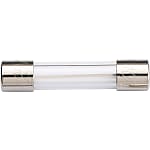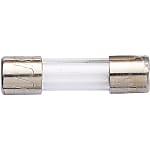(!)NOTE : Windows 7 users won’t be able to use some latest features of eCatalog/WOS since Microsoft is ending support for Windows 7 on 14 Jan, 2020. Please upgrade your system for uninterrupted services.
- Notice of End of Sales for Economy Series Pneumatic Equipment Category. More information.
Glass Tube Fuses(Type:Tube Type)
Brand |
|
|---|---|
| CAD |
|
| Days to Ship |
|
1 items
- Sort By
-
You can add up to 6 items per a category to the compare list.



Glass Tube Fuse (For Inventory Storage)【100-200 Pieces Per Package】
MISUMI
100 or 200-pack products ideal for in-house supply. Rated current range from 1 A to 10 A
Rated Voltage(V) Rated Current(A) Fuse size Fusing property Breaking capacity(kA) Type Representative Standard Lead Wire 125 ~ 250 1 ~ 10 φ 6.4 × 30 mm / φ 5.2 × 20 mm B Type 0.3 ~ 0.5 Tube Type PSE NA From: ₹ 14.40 Days to Ship: 6 Day(s) or more  6 Day(s) or more
6 Day(s) or more
| Brand |
|---|
| Product Series |
| From |
| Days to Ship |
| Rated Voltage(V) |
| Rated Current(A) |
| Fuse size |
| Fusing property |
| Breaking capacity(kA) |
| Type |
| Representative Standard |
| Lead Wire |
You can add up to 6 items per a category to the compare list. | |
| Brand | MISUMI |
| Product Series | Glass Tube Fuse (For Inventory Storage)【100-200 Pieces Per Package】 |
| From | ₹ 1,440.00 |
| Days to Ship | 6 Day(s) or more |
| Rated Voltage(V) | 125 ~ 250 |
| Rated Current(A) | 1 ~ 10 |
| Fuse size | φ 6.4 × 30 mm / φ 5.2 × 20 mm |
| Fusing property | B Type |
| Breaking capacity(kA) | 0.3 ~ 0.5 |
| Type | Tube Type |
| Representative Standard | PSE |
| Lead Wire | NA |
Loading...
Configure
Specification/Dimensions
-
Rated Voltage(V)
-
Rated Current(A)
-
Fuse size
- φ 6.4 × 30 mm
- φ 5.2 × 20 mm
- Ø6.35 X 30Mm
-
Fusing property
- B Type
-
Breaking capacity(kA)
-
Type
- Tube Type
-
Representative Standard
- PSE
-
Lead Wire
- NA
Related Categories to Glass Tube Fuses
FAQ Glass Tube Fuses
- Question: How do glass tube fuses protect electronic circuits?
- Answer: 1. Overcurrent Protection: Glass fuses safeguard electronic circuits by breaking the circuit when excess current flows through, preventing damage.
2. Heat Response: When the current exceeds the fuse's rating, it heats the fuse element, triggering it to melt and interrupt the circuit.
3. Short Circuit Protection: Glass fuses rapidly break the circuit in the event of a short circuit, preventing further damage to components.
4. Thermal Sensitivity: The fuse material's thermal sensitivity ensures quick response to abnormal temperature rises, protecting against overheating. - Question: What is the difference in usage between ceramic and glass fuses?
- Answer: 1. Material Composition: Ceramic fuses use a ceramic body, while glass fuses have a glass tube construction.
2. Voltage Rating: Ceramic fuses often have higher voltage ratings, making them suitable for applications with higher voltage levels.
3. Breaking Capacity: Ceramic fuses generally have a higher breaking capacity, making them more suitable for handling short circuits in high-power applications.
4. Applications: Glass fuses are commonly used in low to moderate power applications, while ceramic fuses are preferred for high-power industrial applications.
5. Cost: Glass fuses are typically more cost-effective, making them suitable for applications with budget constraints. - Question: Can glass tube fuses be used for both AC and DC applications?
- Answer: Yes, glass fuses can be used for both AC (Alternating Current) and DC (Direct Current) applications. The key considerations include:
1. Voltage Rating: Ensure the glass fuse's voltage rating matches the system voltage, whether AC or DC.
2. Breaking Capacity: Verify that the fuse's breaking capacity is suitable for the specific application, considering the potential fault currents in both AC and DC circuits.
3. Current Rating: Select a glass fuse with an appropriate current rating based on the requirements of the AC or DC circuit. - Question: What guidelines should be followed when replacing a glass fuse?
- Answer: 1. Correct Type and Rating: Ensure the replacement fuse is of the same type and has the same current rating as the original.
2. Voltage Rating: Match the voltage rating of the replacement fuse to the circuit requirements.
3. Breaking Capacity: Choose a fuse with a breaking capacity equal to or greater than the original to handle potential fault currents.
4. Fuse Size: Select a fuse with the same physical size and shape as the original to fit properly in the fuse holder.
5. Power Off: Always replace fuses with the power off to avoid electrical shock or damage. - Question: Why might one choose a glass fuse over other fuse types for specific applications?
- Answer: 1. Cost-Effectiveness: Glass fuses are often more affordable, making them suitable for budget-conscious applications.
2. Versatility: They are versatile and applicable to a broad range of general, low to moderate power applications.
3. Easy Visual Inspection: The transparent glass casing allows for easy visual inspection, facilitating quick identification of a blown fuse.
4. Widespread Availability: Glass fuses are widely available, ensuring easy procurement for replacements.
5. Ease of Replacement: Their ubiquity and standard sizes make glass fuses easy to replace in various electronic and electrical systems. - Question: What are the visual indicators of a blown glass tube fuse?
- Answer: 1. Melting or Burn Marks: Inspect the glass casing for signs of melting or burn marks, indicating that the fuse has experienced overheating.
2. Broken or Cloudy Glass: A broken or cloudy appearance of the glass tube suggests a rupture, often due to excessive current.
3. Charred Element: Check the fuse element inside the glass for discoloration or charring, indicating it has melted and interrupted the circuit.
4. Visible Gap in the Element: A gap in the fuse element signifies a break, preventing the flow of current.
5. Frayed Wires: If applicable, check for frayed or damaged wires connected to the fuse, as these can contribute to failures.







How can we improve?
How can we improve?
Thank you for your time.
Your feedback is essential for our continuous improvement
Privacy Policy
Thank you for your cooperation.
Thank you for your time.
Your feedback is essential for our continuous improvement
Please use the inquiry form.
Privacy Policy